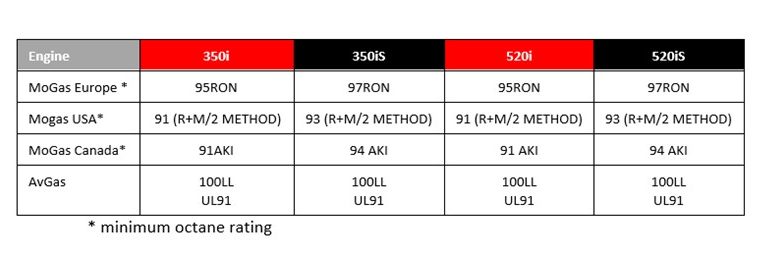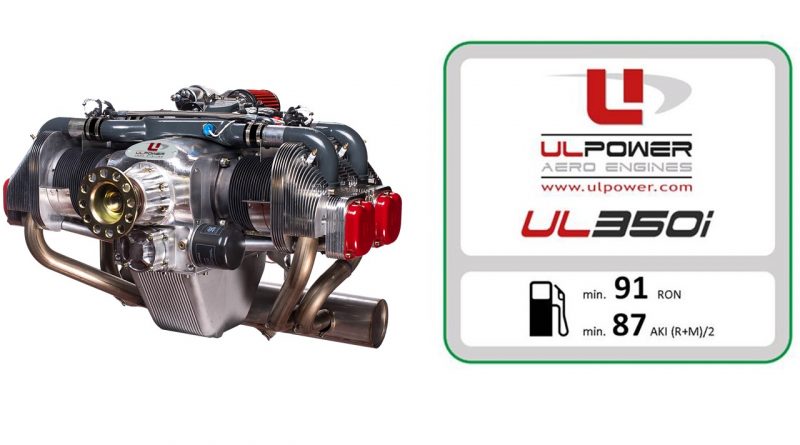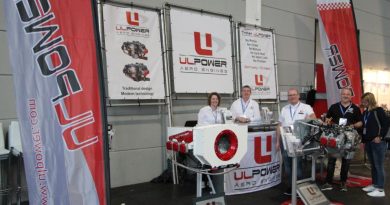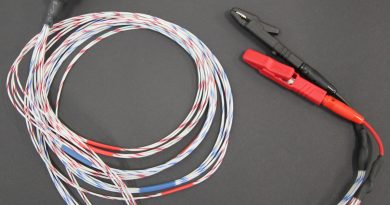New ECU map : UL350i and UL520i can now run on 91Ron fuel
We are pleased to inform you that ULPower Aero Engines have announced that the popular and well proven UL350i and the UL520i engines have an updated ECU map on all new engines (from S/N223501) which will allow the engine to run on MoGas 91 RON fuel as well as MoGas 95 RON, MoGas 97/98 RON, AvGas UL91 and AvGas 100LL. This possibility will open up many doors in regions where customers are struggling to obtain higher octane fuel – and is a most welcome nod from the ULPower Technical team to the growing market for these engines throughout the world.
Mogas octane ratings relate to the compressibility of fuel without detonation – with the higher value octane being able to provide a marginally greater punch in most engines.
Internationally there are different ways of expressing this value, known as RON (Research Octane Number), MON (Motor Octane Number) and AKI (Anti-Knock Index). AKI is derived from (RON+MON)/2
Most European, Asian and African countries use RON, whereas and American/Canadian gas stations use AKI, please take a look at the 2 tables below.
Wherever you are flying, please ensure that you check what the octane rating method is and the value you use is within the acceptable range for your powerplant. ALWAYS use the correct fuel in your engine – or you risk damage to your powerplant and may invalidate your warranty.
The table below is only valid for UL350i / UL520i with a serial number starting from / or higher than S/N 223501 ,

(Please note that this does not apply to the UL260i/UL390i series at the time of writing but is being reviewed as a possible change in the future. There is NO change on the iS range of engines).
IMPORTANT REMARK: for 350i/520i engines with a serial number lower than 223501, you still need to use minimum 95 RON fuel (labelled as 91 AKI fuel in USA / Canada). (Contact your dealer if you would like to update the ECU map in order to be able to run your 350i / 520i engine on 91 RON)
These new ECU maps were tested / written in accordance with ASTM requirements. Flying into ‘lower quality fuel’ zones is no longer such a challenge thanks to this work done in the labs and fully tested on the rigs.
Part of the re-map (which is the definition of mixture and timing based on the engine sensors), has been shared with the ULPower News team….
- The engine runs a little leaner at IDLE
- The engine runs a little richer at WOT
- The engine runs a little richer at low RPM
- The engine runs slightly leaner in cruise
- The average fuel consumption remains almost identical
Is there power-loss when using a lower octane fuel? In tests the team found that there was a negligible power loss on the 520i, and on the 350i an average of 3% lower output across the range – a small price to pay for the added benefits of being able to fly with lower octane when you need to!
As always, we recommend feeding your engine the best fuel available – and if you can access MoGas 97/98 RON or AvGas UL91, your engine will love it, and your performance will generally be improved.
Do remember that matching your prop to your engine is another way to get the best out of your powerplant. We have seen considerable differences in performance with different propellers on the same engine and airframe – and getting that combination right can shorten take off and/or increase cruise speeds… One thing is certain, and that is the team at ULPower Aero Engines are working in the interest of keeping flying accessible and relatively affordable wherever you are in the world.
NOTE: Using incorrect Octane and/or old fuel can cause detonation/pre-ignition! Please make sure to double check the octane rating at the pump and always use fresh clean fuel. When in doubt about fuel quality in your region, sending a sample to a lab to determine the real octane rating is the safest option.
For those flying in parts of the world with concerns about fuel quality, we recommend using fuel from a well know brand, from a reputable station, not to use fuel more than 4 weeks old, and to send fuel samples for checking for quality analysis and identification of possible contaminants on a regular basis.


